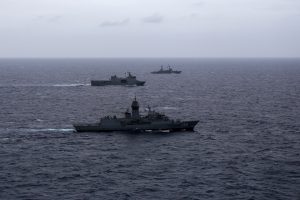Over the weekend Australia and the Philippines began joint naval patrols in the South China Sea. This is the first maritime cooperation activity between the two countries, and comes in the wake of both Australia and the Philippines experiencing recent dangerous provocations from China. Australia is increasingly seeing the Philippines as an essential partner in preserving regional stability.
In recent years Filipino vessels operating in their own waters have come under repeated bullying by China’s navy, coast guard, and unofficial – but tacitly endorsed – maritime militias. Under President Ferdinand Marcos Jr, the Philippines has grown increasingly concerned about these run-ins, and has sought greater maritime cooperation with regional powers to help buttress against Beijing’s attempts to claim Manila’s exclusive economic zone and maritime features within those waters.
Beijing believes that it has sovereignty over almost all of the South China Sea – including most of the islands and sandbars. These claims are in contradiction to the United Nations Convention on the Law of the Sea (UNCLOS), and disputed by several other countries in the region, which have their own legitimate – and legally recognized – claims in addition to territorial disputes among themselves in the sea. In 2016, the Philippines took China to UNCLOS-sanctioned arbitration before a tribunal in The Hague over its “historical claims” to Manila’s waters. The tribunal ruled in Manila’s favor, concluding that Beijing had no legal rights to the bulk of the South China Sea. Beijing, however, has simply ignored the ruling.
Australia maintains a commitment to upholding international maritime law as a key pillar of the mutually beneficial rules that have allowed it to flourish. Yet alongside this, the South China Sea is of critical strategic interest to Australia given that a great deal of its maritime trade – and especially fuel imports – passes through the region. The stability of the sea, which relies on all countries bordering it keeping their commitments to UNCLOS, is therefore something Australia is keen to protect.
This protection is also something Australia sees itself as playing an active role in. It is clear that China has little interest in abiding by UNCLOS, or with any legal rulings that indicate that it must share the sea. This means that through its partnerships, Canberra needs to be engaged in establishing enough deterrence in the region to limit Beijing’s attempts at exerting its might.
This is, of course, easier said than done. Naval exercises and joint patrol can provide a strong indication that there is a great deal of defensive cooperation in the region and this may lead China to restraining itself from larger attempts at maritime control. But given that Beijing has already altered the conditions in the South China Sea through the building of artificial islands and the militarization of these islands, it is unlikely that there will be a reversion to the status-quo ante.
Beijing seems determined to bully its way into fully realizing its illegitimate claims. This would present an unacceptable loss of sovereignty for the Philippines, and a grave threat to Australia’s economic interests. Given the great number of other countries that have both sovereignty and interests threatened by China’s behavior, there is the need for heightened naval coordination within the region.
How far China gets in expanding its control over the South China Sea is reliant on how countries like Australia and the Philippines – and, ultimately, the United States – recognizes and responds to China’s provocative and illegal actions.
Unfortunately, Beijing largely understands the world through the lens of dominance and submission. The idea of mutually beneficial rules like UNCLOS, or other cooperative actions, is something the Chinese Communist Party struggles to comprehend, instead seeing these things as weakness. Therefore the only effective response from other countries is a demonstration of not being cowered.
Canberra understands this. Just over a week ago China turned a powerful hull-mounted sonar onto Australian divers clearing a fishing net out of the HMAS Toowoomba’s propellers in the waters off Japan, causing injury to the divers. In response the HMAS Toowoomba sailed through the Taiwan Strait – a perfectly legitimate route given the strait is recognized as international waters, although that is a recognition that Beijing doesn’t share. China bristles at any vessels passing through the strait. The route was taken to show China that after its actions against the divers, Australia will not be intimidated.
This past weekend’s first joint patrol between Australia and the Philippines – conducted entirely within Manila’s exclusive economic zone, albeit a region that China often exerts itself in – is another sign that Beijing’s attempts at intimidation will not be submitted to. It is also a sign that after Prime Minister Anthony Albanese signed a new strategic partnership with Marcos in September, Australia’s relationship with the Philippines is becoming one of its most important in its neighborhood.

































